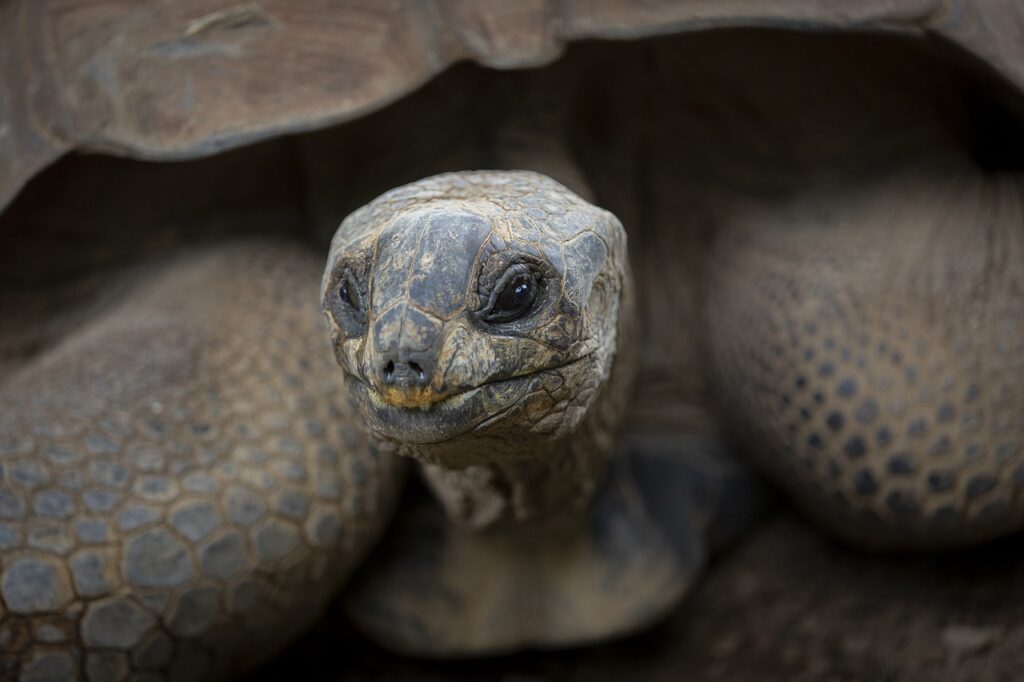
Image: Tortoise in Grass – Pexels
Tortoises need certain temps to be healthy and happy. You must create a thermal gradient in their enclosure for optimal living conditions. That means having different temperature zones from 85-95°F (29-35°C) to 70-80°F (21-27°C). Plus, provide a basking spot at 95-100°F (35-38°C) with a lamp or heater for warmth and UV rays. This way, your tortoise can thermoregulate and exhibit natural behaviors. Ignoring this could lead to health issues – don’t miss out on giving your pet the best living conditions!
Key Takeaways
- Tortoises require a specific temperature range to thrive and stay healthy.
- The ideal temperature for most tortoise species is between 75-85 degrees Fahrenheit during the day.
- At night, the temperature can drop slightly, but it should not go below 70 degrees Fahrenheit.
- It is important to provide a temperature gradient within the enclosure, with a warm basking spot and cooler areas for the tortoise to regulate its body temperature.
- Using a combination of heat lamps, heating pads, and thermometers can help maintain the appropriate temperature in the tortoise’s habitat.
- Using a combination of heat lamps, heating pads, and thermometers can help maintain the appropriate temperature in the tortoise’s habitat.
- Monitoring the temperature regularly is crucial to ensure the tortoise’s well-being and prevent any health issues related to temperature extremes.
- It is also important to consider the humidity levels in the tortoise’s enclosure, as some species require higher humidity levels than others.
- Consulting with a veterinarian or reptile specialist is recommended to determine the specific temperature requirements for your tortoise species.
The Ideal Temperature for Tortoises
Mediterranean tortoise: 75-85°F (24-29°C).
Sulcata tortoise: 80-95°F (27-35°C).
Red-footed tortoise: 75-85°F (24-29°C).
Russian tortoise: 70-80°F (21-27°C).
Remember, slight deviations in temperatures are acceptable. But, extreme changes or long-term exposure to unsuitable temperatures can harm them.
Humidity and shade are also key to creating a hospitable environment. Give them places to hide and bask so they can control their body temperature.
Make your tortoise’s habitat like a spa. Let them relax, sunbathe, and plot their conquest of the world.
Setting Up the Habitat
Setting Up the Tortoise Habitat
A suitable environment is crucial for tortoises to thrive. Here’s a simple 3-step guide to setting up their habitat:
- Temperature: Maintain a temperature range of 75°F to 85°F (24°C to 29°C) during the day and a slightly lower temperature at night. This can be achieved by using a heat lamp or a heating pad.
- Lighting: Provide UVB lighting for at least 10-12 hours a day. This helps the tortoises produce vitamin D3, essential for calcium absorption and overall health. Use a UVB full-spectrum fluorescent bulb specifically designed for reptiles.
- Substrate and Shelter: Use a substrate like cypress mulch, aspen bedding, or orchid bark, which retains moisture without being too wet. Create hiding spots with rocks, logs, or commercial hiding shelters to give them a sense of security.
Additionally, ensure a shallow water dish is available for drinking and soaking. It’s important to monitor the temperature and humidity regularly and make necessary adjustments to maintain an optimal environment.
True Story:
Once a friend of mine set up a tortoise habitat for her pet using all the necessary elements. She meticulously researched the temperature requirements and provided a basking area with a heat lamp. Her tortoise, named Sheldon, thrived in this well-maintained habitat, showing signs of good health and a happy demeanor.
If your tortoise could choose its enclosure, it would probably opt for a ‘tortoise-tic’ mansion with climate control and a personal chef.
Choosing the Right Enclosure
Choosing the right enclosure for your habitat is essential. Here’s a guide to assist you with making an informed choice.
Glass Terrarium: Airtight, provides good insulation, allows visibility.
- Pros: Keeps humidity levels high, ideal for tropical habitats.
- Cons: Susceptible to cracks and requires regular cleaning.
Plastic Container: Durable, lightweight, easy to clean and maintain.
- Pros: Affordable option, provides good ventilation with proper modifications.
- Cons: Limited visibility, may not retain heat well without extra insulation.
PVC Cage: Allows good airflow, durable and customizable design.
- Pros: Converts heat well through thermal conduction of the material.
- Cons: Requires more space due to bulkiness, limited insulation properties.
It’s important to consider other factors when selecting an enclosure. Evaluate the heating and lighting requirements of your habitat prior to making your decision.
Once upon a time, there was a zookeeper named Sarah. She got a new animal – a rare chameleon. Sarah did extensive research and chose the ideal PVC cage for its home. The chameleon flourished in its enclosure, loving the good airflow and customizable design. Thanks to Sarah’s selection of the right enclosure, the chameleon lived happily ever after.
Do your research carefully before deciding on the right enclosure for your habitat. By taking all factors into account and selecting wisely, you can create a comfortable and suitable environment for your animals.
If your temperature control devices fail, your habitat will be a disaster – but hey, at least you’ll have an excuse to finally wear that swimsuit indoors.
Temperature Control Devices
Temperature Control Devices are important for creating a nurturing atmosphere. Here are a few commonly used ones:
- Thermostats
- Heat Lamps
- Aquarium Heaters
- Humidifiers
They need to be suitable for the specific needs of the inhabitant. Insulation, ventilation and other factors should also be considered. Ensuring the optimal temperature helps prevent discomfort and health issues. Invest in reliable devices for the best results. Remember, the perfect temperature is key to happy inhabitants! Unless you’re trying to grow elves, then you need to chill out.
Monitoring and Adjusting the Temperature
Monitoring and adjusting the temperature for tortoises is crucial to ensure their well-being. Proper temperature control helps maintain their health and allows them to thrive in their habitat. Here is a step-by-step guide for monitoring and adjusting the temperature:
- Set up a thermometer: Place a reliable thermometer in your tortoise’s enclosure to accurately monitor the temperature. Ensure it is easily visible and located at tortoise level.
- Determine the optimal temperature range: Research the specific species of tortoise you have to determine their ideal temperature range. This range will vary depending on the tortoise’s natural habitat.
- Adjust the temperature gradient: Create a temperature gradient within the enclosure to allow the tortoise to move between warmer and cooler areas. This can be achieved by using heat lamps, basking spots, and shade areas.
- Use a thermostat: Install a thermostat to regulate the temperature within the enclosure. This will prevent extreme temperature fluctuations and maintain a stable environment for the tortoise.
- Regularly monitor and adjust: Continuously monitor the temperature within the enclosure using the thermometer. Make adjustments as needed to ensure that the temperature remains within the optimal range.
In addition to the steps mentioned above, it is important to avoid direct sunlight or drafts that can affect the temperature. Ensure that the enclosure is well-insulated and properly ventilated.
To maintain a suitable temperature, you can take some suggestions into consideration. Firstly, provide a heat source like a heat lamp or ceramic heater to create a warm basking spot for the tortoise. This mimics the natural sunlight they would receive in the wild. Secondly, use a thermostat to control the heat source and maintain a consistent temperature range. Lastly, periodically check and calibrate the thermometer to ensure its accuracy.
Proper monitoring and adjustment of the temperature for tortoises is essential for their overall health and well-being. It allows them to regulate their body temperature, aids in digestion, and promotes their natural behaviors. By following these guidelines and taking necessary precautions, you can provide a comfortable and suitable environment for your tortoise.
Taking a tortoise’s temperature might not be as exciting as taking your own, but it’s a shell of a good time.
Thermometers and Hygrometers
To unravel the importance of these tools, let’s dive into a thorough description:
Thermometers:
These detect temperature. They come in different shapes, such as mercury, digital, infrared, and thermocouple. They contain a sensor that notices changes in heat and then transforms them into numbers we can read. These give great precision when determining the heat of an object or its environment.
Hygrometers:
These measure the quantity of humidity present in the air or any space. They help us to gauge the humidity content to make sure the right conditions are kept. Popular ones include mechanical hygrometers (using hair or coil) and electronic hygrometers (utilizing sensors). With their accuracy, they help to protect delicate items and deal with issues related to moisture.
Temperature Range:
These two devices offer a wide range of readings from very cold temperatures to very hot ones. This makes them practical for diverse applications such as industrial processes, food storage, greenhouses, labs, hospitals, and homes.
Placement Considerations:
It is essential to have the right placement for precise measuring when using thermometers and hygrometers. They should be away from direct sunlight or sources of heat which could interfere with the readings. Additionally, they should be set at a height that is easy to reach when monitoring.
Calibration:
Calibrating regularly is essential to make sure these devices are still accurate over time. This involves changing the instrument using known reference points to determine any differences from accurate readings due to wear or environmental factors.
Maintenance:
To make sure thermometers and hygrometers work properly, they need to be maintained regularly. This includes cleaning them with suitable solutions or wiping them with a soft cloth often. Also, it is important to prevent physical impact or contact with corrosive materials for them to last longer.
By using thermometers and hygrometers in various settings, we can accurately monitor and adjust temperature to create the ideal conditions. Whether it’s preserving sensitive items or making sure we are comfortable at home, these tools are indispensable in maintaining correct levels of temperature and humidity.
Heat Sources
Heat is generated from different sources, each playing an important role in temperature adjustment. Let’s take a look at the various heat sources and their importance!
- Sunlight gives us natural heat.
- Appliances such as heaters or stoves provide artificial warmth.
- Our own bodies give off biological heat.
Other factors can also influence temperature changes. These include circulation, insulation, and ventilation. They determine how heat flows within a space, impacting its comfort.
By recognizing the significance of the heat sources in managing a comfortable environment, we can take steps to monitor and adjust temperature levels well. Else, it may lead to discomfort or even health issues due to extreme temperatures. So, aim for a balance between warmth and coolness for optimum comfort throughout the day. Oh, and don’t forget – heat lamps are not tanning beds! Your plants won’t appreciate a surprise trip to South Beach.
Heat Lamps
Heat lamps are a must-have for temperature control. They give off heat to make the atmosphere nice and cosy for different purposes. Here’s a rundown of the three types:
- Incandescent – warmth provider, but high power consumption.
- Ceramic – for reptile terrariums, with moderate power usage.
- Infrared – outside heating, with low power consumption.
Plus, they replicate natural sunlight, helping plants grow and animals stay at the ideal temperature in controlled settings. Need-to-know: Proper installation of heat lamps is key for maximum efficiency and avoiding potential dangers.
Heating Pads
Heating pads provide an array of advantages and are employed in many fields. Here’s a list of 6 of them:
- Flexibility: From healing to industry, heating pads can be utilized for multiple purposes.
- Temperature Regulation: Precise temperature control is available, allowing users to attain targeted results.
- User-Friendliness: Heating pads are simple to use, making them suitable for both experts and beginners.
- Safety: Several heating pads feature auto shut-off mechanisms to avoid overheating and mishaps.
- Varied Sizes: Different sizes cater to specific needs, be it a small pad for localized therapy or a large one for heat distribution.
- Efficiency: Modern heating pads are energy-efficient, optimizing electricity usage for optimal performance.
Moreover, these pads benefit health by increasing blood flow in the affected area.
According to the WHO, the ancient Egyptians were known for having used heated stones covered in cloth as primitive heating pads. So, let’s get comfy and rely on these smart pieces of tech to regulate our home temperature!
Heat Emitters
Heat emitters are must-haves for temperature regulation. They play a key role in keeping the heat at the desired level. It’s important to understand the different kinds of heat emitters. Here’s a table with the different types, their characteristics, and applications:
| Heat Emitters | Characteristics | Applications |
|---|---|---|
| Radiators | Efficient heat transfer. Easy to install. | Residential buildings, offices |
| Underfloor heating | Uniform heat distribution. Energy-efficient. | Homes, commercial spaces |
| Fan convectors | Quick heat-up time. Flexible installation. | Hotels, hospitals |
| Electric baseboard heaters | Individual room control. Silent operation. | Bedrooms, living rooms |
Besides these common heat emitters, there are special systems such as infrared panels and radiant ceiling panels. These use radiation instead of convection, offering more targeted heating.
The idea of using heat emitters goes back centuries. The ancient Romans used a type of radiant heating called hypocausts. It was an underfloor heating system with raised floors and channels for hot air produced by furnaces below. This was the start of modern-day underfloor heating systems.
Maintaining the Temperature Levels

Temperature Regulation for Tortoises
Maintaining the ideal temperature levels for tortoises is essential for their well-being. In order to ensure a comfortable environment for these reptiles, follow this 5-step guide:
- Create a Suitable Enclosure: Provide a spacious enclosure with separate areas for basking and cooling. A combination of heat lamps, heating mats, and UVB bulbs can be used to create the right temperature gradient.
- Monitor the Ambient Temperature: Regularly check the ambient temperature of the enclosure using a reliable thermometer. Aim for a range of 75-85°F (24-29°C) during the day and a slight drop to 70-75°F (21-24°C) at night.
- Provide a Basking Spot: Place a heat lamp or basking light on one side of the enclosure to create a hotspot between 90-100°F (32-38°C). This allows the tortoise to thermoregulate by basking under the light when needed.
- Offer Adequate Shade and Cooling: Ensure the enclosure has shaded areas where the tortoise can cool down if the temperature rises. Providing hiding spots or vegetation can help create a cool retreat.
- Adjust for Seasonal Changes: Tortoises may require different temperature levels depending on the season. During winter months, the enclosure may need additional heating to prevent the tortoise from becoming too cold.
It is important to note that different species of tortoises may have specific temperature requirements, so it is crucial to research and understand the needs of your particular tortoise.
In addition to maintaining the temperature levels, it is essential to provide a proper diet, access to fresh water, and a suitable substrate for burrowing.
Real-life Story:
A tortoise owner, Sarah, recalls her experience with temperature regulation. One summer, she left her tortoise’s enclosure unattended during a heatwave, assuming that the shade alone would suffice. Unfortunately, the temperature soared to dangerous levels, causing her tortoise to become lethargic and dehydrated. Fortunately, she acted quickly and relocated her tortoise to a cooler area with ample access to water. Sarah learned the importance of vigilance in maintaining the right temperature conditions for her beloved pet, ensuring its health and well-being.
By following these guidelines and remaining mindful of the temperature needs of your tortoise, you can provide an environment that promotes their optimal physical and physiological development.
Why did the tortoise become an expert at insulation? Because it never wants to get caught in a ‘shell’ of chilly temperatures!
Insulation and Substrates
Insulation and substrates are vital for keeping a space at the right temperature. They stop heat from transferring, giving optimal thermal insulation. Different substrates provide bonuses such as moisture resistance and fire protection. Let’s take a closer look:
| Parameters | Insulation | Substrates |
|---|---|---|
| Definition | Prevents heat transfer between surfaces | Provides structural support |
| Types | Fiberglass, foam, cellulose, spray foam | Wood, concrete, metal |
| Benefits | Reduces energy costs | Enhances durability and improves structural integrity |
Fiberglass and foam insulation materials are often used to block heat in buildings. These materials successfully minimize heat by conduction, convection, and radiation. On the other hand, substrates such as wood, concrete, and metal give structural backing to architectural elements.
Certain insulation materials have added advantages like moisture protection or fire-resistance. This makes them ideal for applications where moisture control or fire safety is a must.
Interestingly, people have been using insulation since ancient times. For example, the Ancient Egyptians used mud bricks as insulation in their homes. Over time, more and more effective insulation materials have been developed, now catering to all kinds of needs.
Light Cycles
Control of light cycles is essential for managing temperature. It helps control the light that plants receive, allowing optimal growth and avoiding overheating.
A table of details about light cycles can improve understanding. Here are some key points: Duration, Intensity, and Spectral Distribution.
| Duration | Intensity | Spectral Distribution |
|---|---|---|
| 12 hours | High | Blue/Red |
| 16 hours | Medium | Blue/White |
| 8 hours | Low | Red |
Other factors include the distance between light and plants, and adjustments for different stages of growth. Monitoring and adjusting light cycles is needed for healthy plant growth.
Neglecting light cycle control can mean missed chances for healthy growth. To make the most of your efforts, it is important to understand and use the right light cycle management techniques.
Avoiding Temperature Extremes
Avoiding Extreme Temperatures for Tortoises
Tortoises are incredibly sensitive to extreme temperatures, and it is crucial for their well-being to ensure they are kept within a suitable temperature range. Failure to do so can result in stress, illness, and even death. To help you provide the best care for your pet tortoise, here are some essential points to keep in mind:
- Keep the enclosure properly insulated: Adequate insulation plays a vital role in maintaining a constant temperature for tortoises. Make sure the enclosure is well-insulated to prevent extreme cold or heat from affecting your pet.
- Provide a temperature gradient: Tortoises require a temperature gradient within their enclosure, allowing them to move between warmer and cooler areas as needed. This allows them to regulate their body temperature and avoid extremes.
- Monitor ambient temperature consistently: Regularly monitor the ambient temperature within the tortoise’s enclosure to ensure it stays within the acceptable range. Avoid sudden fluctuations in temperature, as it can cause stress to the tortoise.
- Use heat lamps or heating pads: In colder climates or during the winter season, it may be necessary to use heat lamps or heating pads to provide additional warmth for your tortoise. This helps them maintain their body temperature and prevent them from becoming too cold.
It is important to note that tortoises, depending on their species, may have specific temperature requirements. Therefore, it is advisable to consult with a reptile veterinarian or do thorough research to ensure you meet the specific needs of your tortoise.
It’s interesting to know that some tortoise species are adapted to tolerate and thrive in extreme temperature conditions. For example, the desert tortoise (Gopherus agassizii) is equipped to withstand and survive in the extreme desert heat, where temperatures can reach up to 130 degrees Fahrenheit.
By providing a suitable temperature environment and avoiding extremes, you can ensure the well-being and longevity of your pet tortoise.
Heatstroke prevention: Tortoises prefer their heat slow and steady, not a fast and furious ‘Too Hot Reptile’ sequel.
Heatstroke Prevention
To avoid heatstroke, remember these four key points:
- Drink lots of water throughout the day.
- Wear light and airy clothes.
- Avoid being outside during peak sunlight hours and seek shade instead.
- Take breaks in cool, air-conditioned areas if outdoors.
Additionally, abstain from caffeine and alcohol as they can cause dehydration. Follow these tips to reduce the risk of heatstroke in hot weather. Prioritize your health by staying cool and hydrated; don’t let the heat take away your outdoor activities. Be aware of heatstroke signs and be proactive in protecting yourself.
Cold Stress Prevention
Stay safe from cold stress by taking preventive measures today! Here are some tips:
- Dress appropriately; layer clothing, wear hats and gloves.
- Keep hydrated with plenty of fluids.
- Warm-up regularly with physical activity.
- Take breaks to limit exposure to cold temperatures.
- Eat nutritious meals to provide energy for the body to generate heat.
- Avoid caffeine and alcohol to prevent dehydration and heat loss.
- Remember, it’s better to sweat than to freeze or disappear in extreme temperatures.
- Prioritize your health and safety for a better tomorrow!
Frequently Asked Questions
1. What temperature do tortoises need?
Tortoises generally need a warm environment with a basking area that ranges from 85 to 95 degrees Fahrenheit (29 to 35 degrees Celsius). The ambient temperature in their enclosure should be around 75 to 85 degrees Fahrenheit (24 to 29 degrees Celsius).
2. Can tortoises tolerate lower temperatures?
While some tortoise species can tolerate lower temperatures temporarily, it is important to avoid exposing them to prolonged cold or below their required temperature range. Cold temperatures can significantly impact their metabolism and overall health.
3. What happens if tortoises get too cold?
If tortoises get too cold, their metabolic processes slow down, which can lead to digestive issues, respiratory problems, and weakened immune systems. It’s crucial to provide a warm and regulated environment to prevent these health issues.
4. Can tortoises withstand high temperatures?
Tortoises are adapted to withstand higher temperatures, but extreme heat can still be detrimental. It’s important to provide a shaded area or a cooler retreat within their enclosure to allow them to regulate their body temperature and avoid overheating.
5. How can I maintain the temperature for my tortoise?
You can maintain the temperature for your tortoise by using a combination of heat lamps, ceramic heat emitters, under-tank heaters, or heat pads. It’s important to monitor the temperature regularly using a thermostat and adjust the heating setup as needed.
6. Are there specific temperature requirements for different tortoise species?
Yes, different tortoise species have specific temperature requirements. It’s essential to research and understand the specific needs of your tortoise species. Some species may require slightly higher or lower temperatures, so it’s crucial to provide the appropriate conditions.
Conclusion
Tortoises need special temps to be healthy. Providing the right heat helps them stay comfy and avoid health problems. Their ideal temp depends on where they’re from. Different species have different needs, so it’s important to research and understand yours. Some prefer hot climates, others prefer cooler ones.
You also need to create a thermal gradient inside the enclosure. This means making areas with different temps so that your tortoise can choose the one they like best. This helps them regulate their body temp.
Heat lamps, heating mats or ceramic heat emitters can be used to get the right temperature. Measure the temperature precisely with a thermometer near the tortoise, not just the room temp. Monitor the temps regularly to make sure they stay within the recommended range.
Pro Tip: Make a warm basking area for your tortoise. It’ll improve their wellbeing and they can do natural things like sunbathing and digesting.
References




